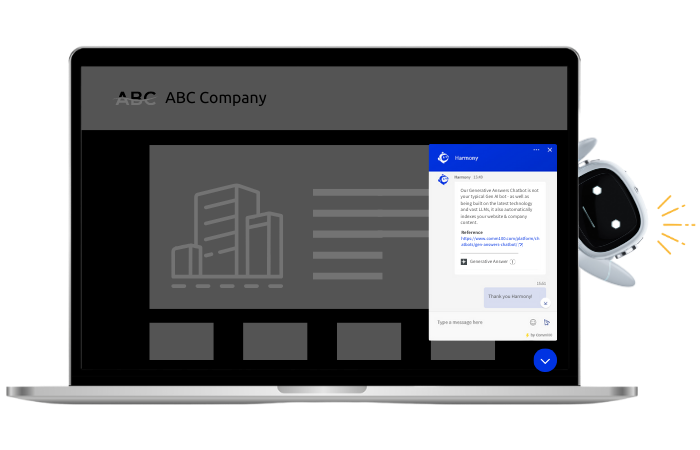Accessibility is critical in healthcare. Since 2016, the United Kingdom’s National Health Service has enforced the Accessible Information Standard. In the US, the CDC follows the Disability Inclusion in Programs & Activities toolkit. In December 2022, Health Canada published its first Accessibility Plan. These policies outline the commitment of governments to keep accessibility top of mind when delivering services, programs, and communication.
Clearly, healthcare providers face a need to communicate with their patients in an accessible way. Live chat is being used by many to help them do this. This tool allows patients to receive assistance in real-time through a chat window on an organization’s website or mobile app. This one-on-one support is secure, fast, and meets the needs of today’s accessibility standards. Services that live chat can help to deliver include:
- Scheduling appointments and follow-ups
- Providing health service information
- Answering common questions about health issues or treatments
- Delivering telemedicine solutions
- Offering emotional support to patients
In this article, we’ll look at how live chat can help healthcare organizations ensure they are offering accessible services and support to every patient.
1. Inclusivity at its core
The very nature of how live chat works makes it an accessible communication channel. Compared to other communication channels that rely on a single method of control, live chat offers inclusivity by design. Live chat providers like Comm100 offer WCAG compliant live chat solutions that allow patients to reach out using only keyboard commands if desired. When utilized, this keyboard feature replaces standard mouse actions to make the chat more accessible to those with motor disabilities.
Some live chat software also offers integrated audio & video chat. Video & audio chat can benefit patients that may have difficulty reading or typing, including those with poor vision or dyslexia. For patients with hearing loss, sign language may be the preferred method of communication, and only video chat can deliver on this.
Live chat can also support language variation for patients. Through auto chat translation, patients can reach out using the language that they are most comfortable with, and have their message automatically translated on the other end.
The WCAG accessibility standard means that live chat can support other standards such as text to speech for screen readers. This means that assistive technologies won’t be challenged by the live chat window and can read out chats and interface buttons on the live chat widget. For additional customization, Comm100 Live Chat also supports text resizing up to 200% and adjustable text colors.
2. Accessibility through remote care
One of the most significant ways that live chat helps to improve accessibility in healthcare is by enabling remote care delivery for patients. Studies have shown that in areas with fragmented health systems, communication with providers is a significant barrier for people in seeking healthcare. Using live chat, healthcare providers can offer telehealth services like consultations and prescription renewals that would typically require visits to physical clinics. Remote care promotes wider access to healthcare services across all levels of society by removing a range of barriers.
Patient barriers to healthcare may include obligations to family or work that make clinic visits during work hours challenging, and sometimes impossible. When combined with a chatbot or task bot, live chat can be offered around the clock to mitigate these issues and help patients receive support when its suits them, and not just during typical business hours. Simply by avoiding the need for patients to travel to an office and then sit through potentially long waits, live chat makes accessing care easier while improving the patient experience.
These virtual visits are not only convenient – they also provide other benefits to patients that have reason to avoid in-person contact. For immunocompromised patients, the ability to check in with a doctor or other health provider remotely can reduce overall risk and improve safety. By improving patient engagement, live chat can help improve patient quality of life by reducing isolation and providing additional independence to those that face mobility challenges.
3. Improved patient engagement and education
Healthcare providers often take on the role of educators when it comes to patient care routines, and live chat is an excellent tool for delivery of patient education and engagement. Growing evidence shows that improved engagement can even lead to better health outcomes for patients. One of the ways that live chat improves engagement is by making it easier for patients to access medical information and guidance from healthcare professionals at any time and place. This can include patient reminders, assistance with scheduling, pre-care and post-care instruction, and referrals to other medical supports as necessary.
As a two-way communication channel, live chat enables patients to more easily provide feedback and clarify any doubts or concerns. The fast response speed of live chat compared to other communications channels also gives health care providers more time back to spend with the patients that need it. If patients need time to respond, live chat allows them as much time as necessary to respond while still receiving real-time responses.
As an engagement tool, live chat can also leverage mobile and SMS communication to deliver targeted messages to patients. These messages can promote healthy behaviours or provide reminders and alerts that help patients maintain their healthcare schedule.
4. Better understanding of patients
As a digital communication channel, live chat can be easily integrated with other digital systems to provide health care providers with a wealth of patient data. By integrating live chat with record keeping tools like Salesforce CMS for examples, healthcare providers can combine this useful data together, removing data siloes and providing them with a more detailed picture of every patient so they can offer more helpful and accurate support.
Having a digital record of patient interactions can have other benefits too, like the ability to view live chat reports that demonstrate patterns in patient behaviours and outcomes. Health care providers can use this data by directing staff resources where it’s needed most to see the best possible outcomes. Optimized staffing should see improved access to support and shorter waits for patients, and greater personalization in the care provided.
Wrap up
Comm100 Live Chat removes barriers for patients with accessibility needs, enhances patient engagement, and delivers data to improve support and services. To learn more about Comm100 Live Chat and how Healthcare companies are using it, take a look here.






